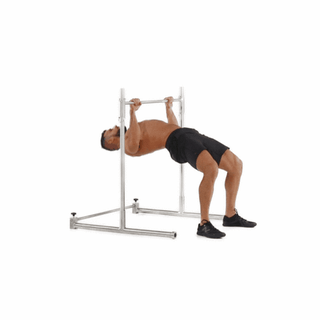
When most people think of building the a powerful, strong body, they think about adding muscle on their chest, arms, and shoulders. They also think of doing a handful of classic exercises, moves like bench presses and deadlifts, and squats, and curls, and pullups.
All of that is great, of course, but it omits an exercise that’s critical for your growth, and for the overall health and balance of your torso. That exercise is the barbell row, and it’s a move you absolutely need to have in your training repertoire.
The barbell row is a fundamental exercise that will pack serious meat onto your back — and it does more than that, too. It also helps bulletproof your shoulders, building the back muscle needed to prevent your shoulders from rolling forward when you stand up, a common issue for lifters who bench press often. And it helps reinforce good principles of scapular retraction, which occurs when you squeeze your shoulder blades and is both critical for shoulder health and for your ability to execute pullups both safely and properly.
The key to getting the most out of the barbell row: Doing it right.
What’s So Special About the Barbell Row?

Getty ImagesWestend61
The row is a staple in physique-building. You’ve likely some row variations before, perhaps doing dumbbell rows or cable rows. But it’s the barbell row that just might take your training to the next level.
Why? Start with the fact that you can simply go heavier on the barbell row than you can on most other rows, since you’re using both arms (instead of one) to lift the barbell. The move also challenges more muscle groups than most rows. A typical row attacks your lats and rhomboids, and some shoulder stabilizer muscles. A barbell row offers a constant downward pull on your entire back, elevating muscular stress. Additionally, you must hold your torso in position to do a barbell row, and isometric challenge that attacks spinal stabilizing muscles and lower leg muscles to fatigue. Yes, this is a back move. It’s a full-body move too.
That’s a lot of bang for your training buck, although you’ll want to be careful about how and when you barbell row. Do it at the start of your workout; whenever you’re focusing on muscularly taxing compound exercises like this, you want to hit them early. Make this move your main focus when you train it, and aim to do it at least twice a week.
The Muscles You Work When You Barbell Row

Getty Imagesdigihelion
The beauty of the barbell row is how many muscles are recruited to accomplish the move. The hallmark of any pulling motion is the involvement of the lats (latissimus dorsi), the large, fan-shaped muscles on your back that are the main extenders of your upper arms. These are the two thick slabs of muscle that stretch from below the shoulder blades all the way down to your lower back (and the thoracolumbar fascia).
Based on how you are pulling with your elbows in relation to your torso, you can adjust the emphasis of a lot of other complementary muscles. Your biceps and forearm muscles also assist in the pulling motion, as do your brachialis muscles, the muscles that lie underneath your biceps and help flex your elbows.
A series of smaller stabilizing muscles are also involved in a barbell row, including the teres major, rear deltoids, and your rotator cuff tendons. Any exercise that utilizes these muscles safely is good; you want them strong to protect your shoulders from injury.
Lastly, a series of muscles in your lower back, the erector spinae and quadratus lumborum, get a major workout. These muscles have to work overtime to make sure your spin stays in alignment. This is a highly integrated exercise with plenty of takeaway.
The Basics of the Barbell Row


Men’s Health
Load a barbell in a rack with a medium-heavy weight. Grasp the bar with an overhand grip, hands about shoulder-width apart. Bend your knees slightly and push your butt back, shifting your torso as you do so. The bar should be resting at the bottom of your thighs. Your hamstrings should be engaged, and your core should be tight. Make sure that your shoulders are on a higher plane than your butt, and that your shins are perpendicular to the ground. This is the start.
Now squeeze your shoulder blades. Then bend at the shoulders and elbows, pulling the bar upwards and back, trying to touch it to your torso, just a few inches above your belly button. Your elbows should maintain a 45-degree angle from the body and you should be pulling mostly with your upper arm. Pause when the bar touches your torso (or very nearly does), then slowly return to the start. Think of doing 3 sets of 8 to 10 reps.
Three Things To Watch For When Barbell Rowing

Getty Imagesalvarez
Keep Your Elbows (Pretty) Tight
Keep the elbows a few inches away from your side. Your shoulder works best when it’s allowed a certain degree of freedom, so aim to keep your upper arm at anywhere from a 20- to 45-degree angle relative to your torso. This will keep your rotator cuff muscles and rear delts involved in the row, getting them valuable work.
Don’t Row High
One of the most common mistakes made in the row is pulling back the elbows too far. Contrary to popular belief, you don’t need to pull your elbows so high that they wind up higher than your torso. Doing so is actually not good.
When the elbows finish higher than the torso, the head of the humerus (your upper arm bone) can push forward into the joint capsule of the shoulder. Do this repeatedly, and you could actually make the shoulder joint less tight. To be safe, row until your elbows are in line with your torso, or, at most, 2 inches past it.
Lock In Your Core
The barbell row can add a lot of stress on the entirety of the back. Spinal integrity is key, and you should always consider it when choosing your weight.
Use only as much weight as you can while maintaining a strong posture. That means your back should be flat and shouldn’t round forward. If your back is rounding forward, then you’re using too much weight.
Remember: Your lower back is a key part of a barbell row, and it’s reaping a lot of the benefit from the move, too. The stabilization work it gets is similar to the work it gets during a deadlift.
Your Ideal Palm Position
There are two ways to grip the bar during barbell rows. You can either use the overhand grip, as described above, or you can use an underhand grip.

Both styles have strengths and weaknesses. If you have front shoulder issues, you may find that the underhand grip, also known as the supinated grip, is a little easier. If not, work to master and own the overhand grip barbell row first. The supinated grip barbell row increases the involvement of the biceps, so your elbows wind up staying closer to your torso. The overhand grip has more benefits, though, training your grip, rear delt, and upper back more aggressively.
Barbell Row Variations
The classic barbell row should always have a place in your program, but that doesn’t mean you can’t mix things up with some barbell row variations. Try these three moves out; they’ll help you perfect your barbell row technique and strengthen your back and entire body in new ways.
Dead Stop Pin Row
View this post on Instagram
A post shared by David Otey, CSCS PN1 (@davidscottpt) on
Pin rows in a rack can limit the range of motion, allowing you to work in a position that you can own, and taking some stress off your lower back. This gives you a chance to work on row technique and make sure your body position is clean, while also using slightly heavier weights than you normally would.
To do the dead stop pin row, simply set up a pair of pins at about knee height, or a little higher, and place the bar on the pins. Grasp the bar and get in good row position; make sure to brace your core and push your butt back. Pull the bar off the pins and to your torso, just as you would when doing a regular barbell row, then lower back to the pins. Do 3 sets of 8 to 10 reps.
Hex Bar Row
View this post on Instagram
A post shared by Eb Samuel (@ebenezersamuel23) on
The neutral grip of the hex bar is a great way to find the middle ground between the pronated and supinated grips. To do hex bar rows, load a hex bar with weight, then position yourself inside of it. Grip it’s handles, brace your core and push your butt back, taking all the other steps you’d do with a barbell row. Do 3 sets of 8 to 10 reps.
Inverted Barbell Row


Men’s Health
The inverted barbell row gives you a chance to focus on building a strong pull and it minimizes stress on your lower back stabilizers. Don’t underestimate it because it’s bodyweight, though; it’s harder than it looks. The best part about the inverted row is you can easily change the degree of difficulty. Set the bar up higher in the rack to make it easier. Set it up lower in the rack for greater challenge.
To do the inverted barbell row, set up a barbell in a rack, and slide under it, then grab it with an overhand grip. Your heels should be on the ground, and your core and glutes should be squeezed. Keeping your entire body in a straight line, pull your torso upwards, aiming to touch the bar to your lower ribcage.
Do 3 sets of 8 to 10.
Source: Read Full Article
